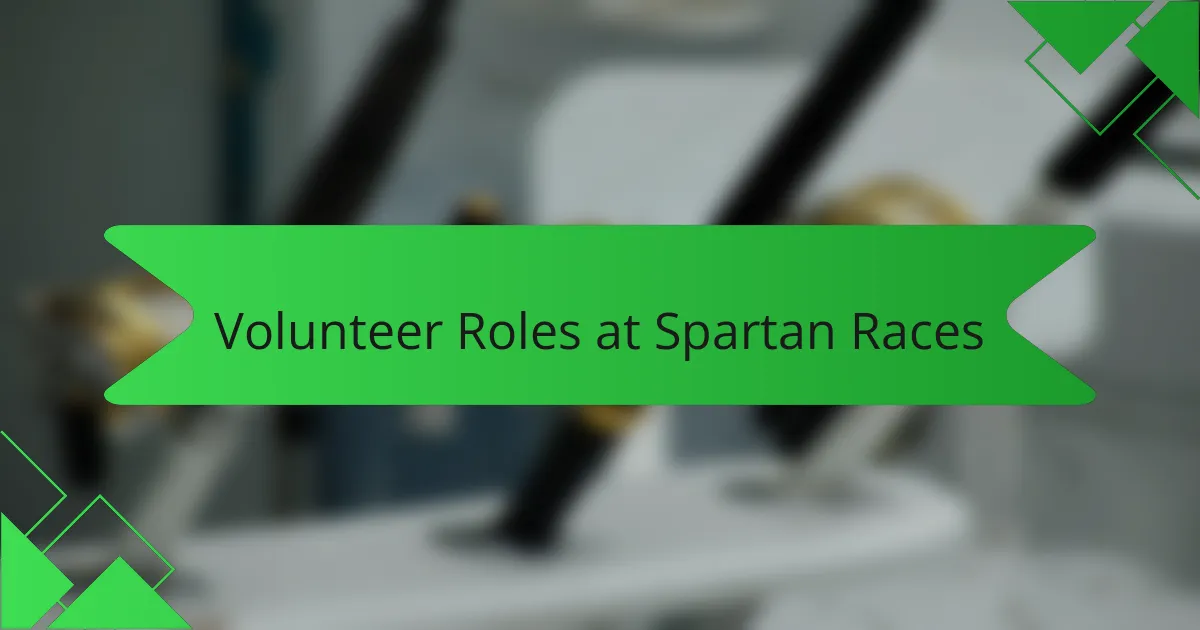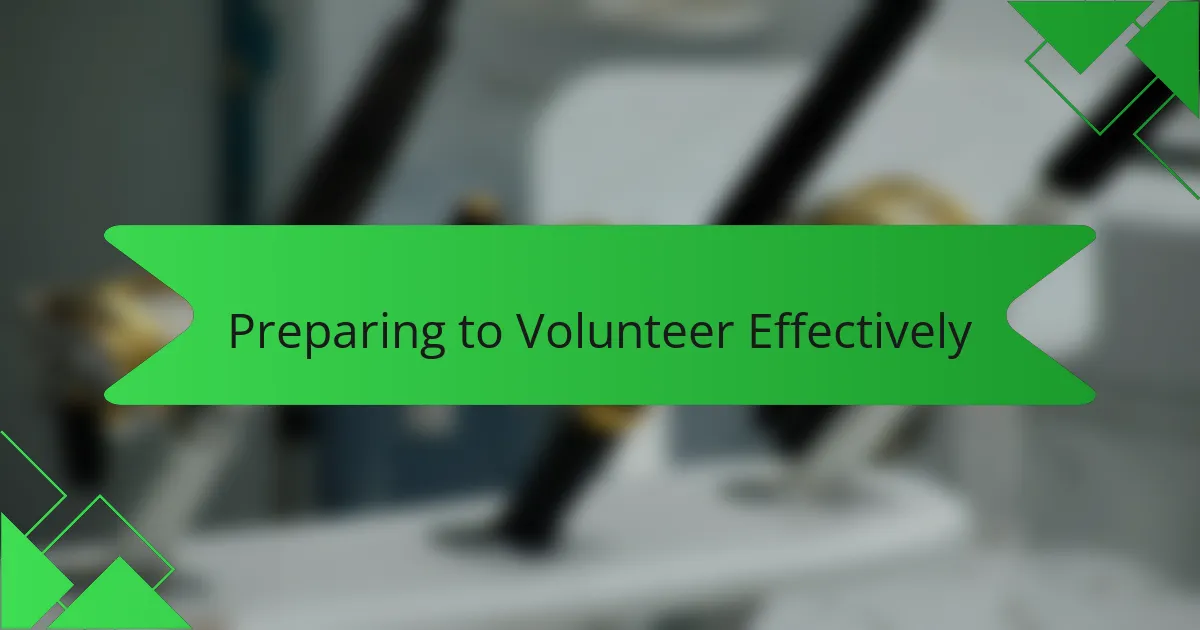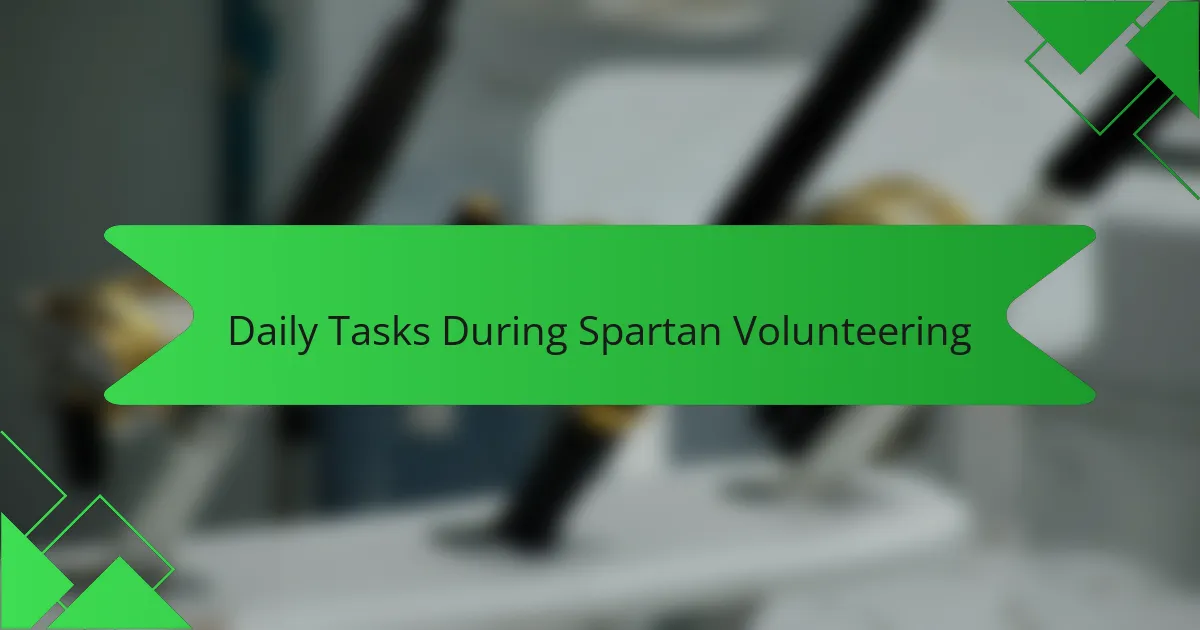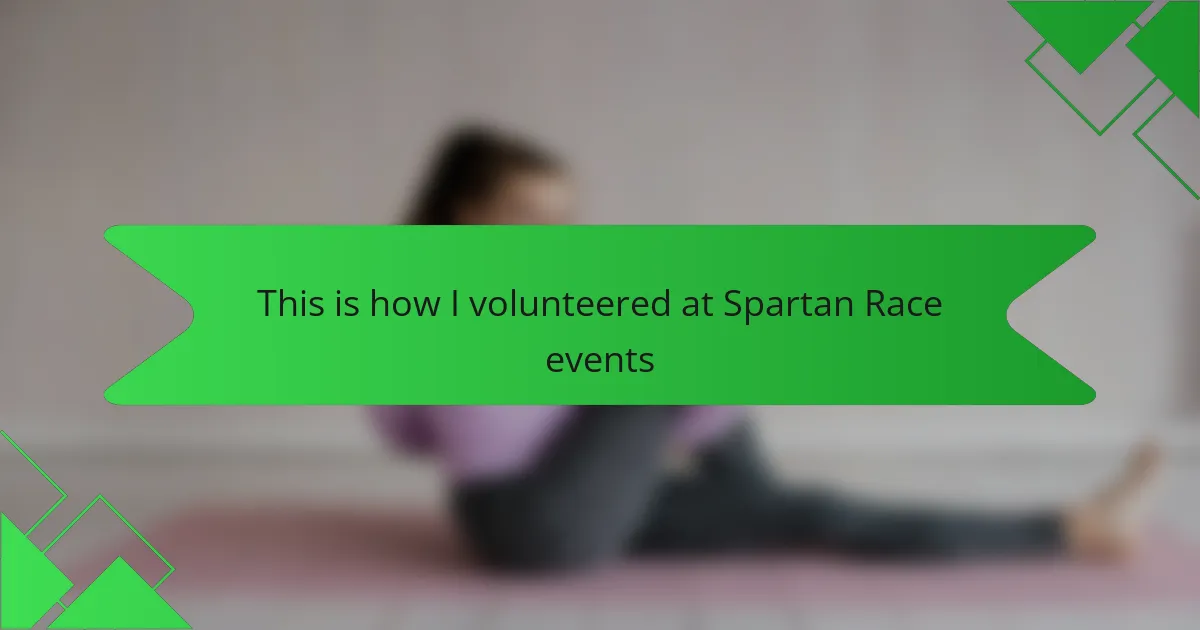Key takeaways
- Obstacle Course Racing (OCR) is a sport that tests physical and mental limits through various challenges, fostering a sense of camaraderie among participants.
- Spartan Race events offer a range of distances and levels of difficulty, creating an engaging community where even first-time participants feel encouraged and supported.
- Volunteering at these events involves diverse roles that contribute to the success of the race, allowing volunteers to connect meaningfully with participants and the overall experience.
- Personal rewards from volunteering include a sense of fulfillment, boosted confidence, and the formation of strong friendships through shared challenges.

What is Obstacle Course Racing
Obstacle Course Racing, or OCR, is a sport that combines running with physical challenges like climbing, crawling, and jumping over various obstacles. It’s more than just a race; it’s a test of strength, endurance, and mental grit. Have you ever wondered what it feels like to push your limits in a way that’s both fun and demanding?
When I first encountered OCR, I was struck by how it turned a simple run into an adventure. Each obstacle requires a different skill and mindset, which keeps you engaged and constantly guessing what’s next. It’s not just about speed; it’s about strategy and determination, which makes crossing that finish line incredibly satisfying.
What fascinates me most is how OCR brings people together—strangers become teammates, encouraging each other through mud pits and rope climbs. It’s a unique blend of competition and camaraderie that I haven’t found in other sports. Can you imagine the sense of accomplishment that comes from conquering obstacles you once thought impossible?

Overview of Spartan Race Events
Spartan Race events are the quintessential embodiment of obstacle course racing, offering varied distances and degrees of difficulty to challenge anyone from beginners to seasoned athletes. What always amazes me about these events is the sheer diversity—they range from the Sprint, a quick and intense 5K with about 20 obstacles, to the Beast, pushing you through a grueling 12-mile course filled with more than 30 obstacles. Have you ever thought about how something that sounds so physically demanding can also be incredibly inviting and accessible? That balance is what makes Spartan Races stand out.
One thing I noticed volunteering was the unmistakable energy that buzzes through the event grounds. Every Spartan Race feels like a huge festival of effort and encouragement, where participants and volunteers alike share a common goal: to overcome whatever the course throws at them. The obstacles themselves—walls to climb, ropes to swing on, and muddy trenches to crawl through—aren’t just physical challenges but symbols of personal growth. I often find myself inspired just watching people push beyond what they thought they could do.
What really sets Spartan Race apart is the tight-knit community it fosters amidst the chaos of mud and sweat. From elite athletes to first-timers, everyone is cheering each other on, creating an uplifting atmosphere that stays with you long after the race. Reflecting on my experience, I keep asking myself: how often do we get to be part of something that demands so much yet gives back even more in camaraderie and self-belief? For me, Spartan Race events are exactly that kind of rare, unforgettable experience.

Volunteer Roles at Spartan Races
When I volunteered at Spartan Races, I quickly realized that the roles were as varied as the obstacles themselves. From guiding runners through tricky sections to handing out water, each position felt crucial in keeping the event running smoothly. Have you ever felt that sense of pride when your small action helps someone achieve a big goal? That’s exactly the vibe I soaked in every shift.
One of my favorite moments was working at the checkpoint stations, where I cheered racers on and ensured their safety. Standing there, I witnessed transformations—tired faces lighting up with newfound strength after conquering a tough obstacle. It made me appreciate how volunteers don’t just manage logistics; we become part of the support system that lifts every athlete higher.
Sometimes, I took on more physically demanding roles like helping reset obstacles or assisting with setup early in the morning. It surprised me how giving my hands—and sometimes my own sweat—to the race deepened my connection with the Spartan community. Volunteering became not just about helping others but also about feeling like I genuinely belonged to something bigger than myself.

Preparing to Volunteer Effectively
Getting ready to volunteer at a Spartan Race means gearing up both mentally and physically. I learned quickly that wearing comfortable clothes and sturdy shoes was a must, but so was preparing for long hours outdoors—whether under intense sun or unpredictable weather. Have you ever underestimated how much standing and moving around can take it out of you? Trust me, being prepared made all the difference.
I also found it important to understand my role fully before race day. Reading volunteer guides and asking questions gave me a clearer picture of what to expect, which eased any nervousness. It’s one thing to show up ready to help, but it’s another to feel confident that you’re actually making the event flow smoothly.
What surprised me the most was how crucial communication became during the event. I made it a habit to check in regularly with team leaders and fellow volunteers, which not only helped with coordination but also built a sense of camaraderie. Have you ever noticed how just a few words of encouragement can boost everyone’s energy? That simple connection kept me going when fatigue started to creep in.

Daily Tasks During Spartan Volunteering
Every morning at the Spartan events, my first task was setting up the course markers and safety signage. It might sound straightforward, but I quickly realized how vital these markers were—they guided racers and kept them safe, especially in the muddier sections where paths weren’t obvious. Have you ever experienced how something so simple can have such a big impact on the flow of an event?
Throughout the day, my role shifted to managing water stations and cheering on exhausted racers as they pushed themselves through grueling obstacles. There’s an energizing buzz in the air when you shout encouragement and see someone’s face light up with renewed determination. It made me feel like I was part of their personal victory, even if just for a moment.
I also found myself jumping into more hands-on tasks, like helping reset obstacles after heavy use or moving supplies between race sections. These physical jobs kept me connected to the heartbeat of the event. Sometimes, after hours on my feet, I’d pause and think: Isn’t it incredible how a little sweat and teamwork behind the scenes make an entire race experience unforgettable?

Challenges Faced and Solutions
One challenge I often faced volunteering was managing the unpredictable weather. Rain could quickly turn mud pits into slippery hazards, making it tough to keep obstacles safe and runners steady. To tackle this, our team stayed vigilant, constantly assessing and adjusting obstacle conditions, which taught me how crucial flexibility is in these dynamic events.
Another hurdle was communicating clearly in the chaos of cheering crowds and roaring athletes. At first, I struggled to get messages across, but I soon found that using simple hand signals and quick check-ins with fellow volunteers made a huge difference. This experience showed me that effective communication doesn’t have to be complicated; it just needs to be consistent and clear.
Physical fatigue was definitely part of the package—long hours on my feet carrying supplies or resetting obstacles left me exhausted. I learned to pace myself and take short breaks when possible, reminding myself that even small moments of rest helped me stay sharp and enthusiastic for the racers depending on us. Have you ever underestimated how much stamina volunteer work demands until you’re right in the thick of it? I sure did.

Personal Rewards from Volunteering
Volunteering at Spartan Races gave me a deep sense of fulfillment I hadn’t expected. Watching athletes conquer obstacles I helped maintain made me feel like I was part of their triumph, even though I wasn’t running the course myself. Isn’t it amazing how being behind the scenes can offer such a powerful connection to the race experience?
There’s also a surprising boost in confidence that comes from volunteering. I remember feeling proud knowing my efforts—whether cheering on racers or setting up gear—actually mattered. It reminded me that every small role contributes to a bigger mission, and that sense of purpose stayed with me long after the event ended.
Perhaps the most rewarding part was the friendships forged along the way. Sharing challenges and victories with fellow volunteers created a tight bond. Have you ever found that working together towards a common goal sparks unexpected camaraderie? For me, those relationships turned a few hours of volunteering into something truly special.
